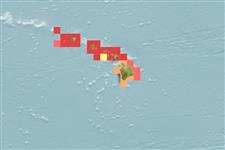分類 / Names
俗名 | 同種異名 | Catalog of Fishes(屬, 種) | ITIS | CoL | WoRMS | Cloffa
Teleostei >
Perciformes/Uranoscopoidei (Sand dwellers)
鱸形目 (Sand dwellers) >
Ammodytidae (Sand lances)
玉筋魚科 (Sand lances)
Etymology: Ammodytoides: Greek, ammos = sand + Greek, dytes = anyone that likes immersions, diving (Ref. 45335); pylei: Named for Richard Pyle.
Eponymy: Dr Richard Lawrence Pyle (d: 1967) is an ichthyologist and marine biologist at Bishop Museum, Honolulu, which he joined as an Ichthyology Collections Technician (1986). [...] (Ref. 128868), visit book page.
More on authors: Randall, Ida & Earle.
Environment: milieu / climate zone / depth range / distribution range
生態學
海洋 底中水層性; 深度上下限 7 - 120 m (Ref. 10672). 熱帶; 24°N - 18°N, 161°W - 151°W (Ref. 57359)
Eastern Central Pacific: Molakai to the Ladd Seamount, Hawaii.
中太平洋東部: Molakai 到 Ladd 海洋山脊,夏威夷。
大小 / 重量 / 年齡
Maturity: Lm ? range ? - ? cm
Max length : 17.3 cm SL 雄魚/尚未辨別雌雄; (Ref. 10672); 14.2 cm SL (female)
Loose aggregation feeds on zooplankton as much as 5 meters above the sandy bottom. Highly protrusible premaxilla facilitates feeding on small animals of the zooplankton (Ref. 10672).
解放群集吃浮游動物高達 5 公尺上方沙質底部。 能高度伸展的前頜骨促進吃浮游動物的小動物.(參考文獻 10672)
Life cycle and mating behavior
成熟度 | 繁殖 | 產卵場 | 卵 | 孕卵數 | 仔魚
中太平洋東部: Molakai 到 Ladd 海洋山脊,夏威夷。
Randall, J.E., H. Ida and J.L. Earle, 1994. Ammodytoides pylei, a new species of sand lance (Ammodytidae) from the Hawaiian Islands. Pac. Sci. 48(1):80-89. (Ref. 10672)
IUCN 瀕危狀態 (Ref. 130435: Version 2024-1)
人類使用
漁業: 自給性漁業
工具
特別的報告
下載 XML
網路資源
Estimates based on models
Preferred temperature (Ref.
123201): 15.6 - 25, mean 20.3 °C (based on 2 cells).
Phylogenetic diversity index (Ref.
82804): PD
50 = 0.5010 [Uniqueness, from 0.5 = low to 2.0 = high].
Bayesian length-weight: a=0.00324 (0.00140 - 0.00746), b=3.07 (2.88 - 3.26), in cm total length, based on LWR estimates for this (Sub)family-body shape (Ref.
93245).
營養階層 (Ref.
69278): 3.4 ±0.45 se; based on food items.
回復力 (Ref.
120179): 中等的, 族群倍增時間最少 1.4 - 4.4年 (Preliminary K or Fecundity.).
Fishing Vulnerability (Ref.
59153): Low vulnerability (11 of 100).
